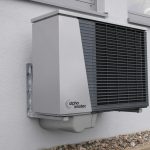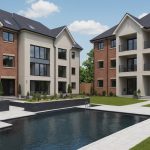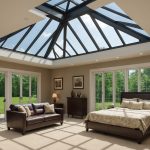Transform dim spaces with bespoke pyramid skylights that blend style and functionality. These custom-designed structures flood interiors with natural light, enhancing ambiance while reducing energy costs. Precision engineering and premium materials ensure durability and thermal efficiency, making them an ideal choice for modern homes and commercial spaces alike. Discover how tailored skylights can brighten your environment with elegance and lasting performance.
Understanding Pyramid Skylights and Their Benefits
Modern Pyramid Rooflight Designs serve as striking architectural features that maximize natural light while adding a distinctive aesthetic appeal to both residential and commercial spaces. Their unique geometric shape, with four sloped sides, enables a more effective dispersal of daylight compared to traditional flat skylights. This design choice creates a warm, inviting atmosphere and enhances the visual interest of interior spaces.
Topic to read : How to Optimize Indoor Air Quality with Smart Home Devices?
Key benefits of these skylights include improved aesthetics, energy efficiency, and increased interior brightness. By capturing more diffuse daylight, pyramid skylights reduce the need for artificial lighting during daytime hours, leading to potential energy savings. Additionally, their structural form allows for better light diffusion, minimizing glare while evenly illuminating the space. Their high-quality materials provide excellent durability and weather resistance, making them suitable for a range of climates and building types.
These skylights seamlessly integrate into both modern and traditional building designs. In contemporary architecture, they often serve as standout features, elevating the overall style. For traditional settings, bespoke options can reflect period-correct details, blending classic charm with modern performance. Whether for an atrium, kitchen, or living room, pyramid skylights not only brighten the interiors but also add architectural value and a sophisticated touch.
Also read : How Can Advanced Ceramics Improve Heat Resistance in UK Manufactured Engines?
Design Features and Material Options for Pyramid Skylights
Common Design Variations and Sizes
Pyramid skylight shapes and sizes are engineered to optimise daylight while adapting to a variety of architectural environments. The defining four-sided sloped design is available across a broad range of dimensions. Common residential and commercial projects integrate pyramid skylights sized from compact 600 mm units to expansive 6000 mm structures, achieving daylight harvesting benefits and tailored visual impact. Flat roof skylight compatibility allows seamless installation on both modern and traditional properties. Bespoke manufacturing ensures each skylight is shaped precisely for its intended opening, enabling easy integration with unique ceiling or roof pitches. Modular approaches accommodate square, rectangular, and even elongated shapes—each selected to enhance natural lighting improvements, light diffusion through pyramid skylights, and architectural presence.
Material Choices: Glass vs. Polycarbonate
Glass skylight materials provide exceptional clarity and durability, commonly favoured for residential skylight solutions due to their high performance in thermal insulation and noise reduction. Toughened or laminated glazing is usually specified to meet skylight safety features and rigorous building standards. Glass allows for pyramid skylight energy efficiency improvements—including U-values as low as 1.2 W/m²K—while enabling pyramid skylight glazing types such as neutral solar control or tinted glazing options. These coatings limit heat gain and offer UV protection, supporting optimal indoor comfort and preventing furnishing fade.
Polycarbonate skylight features offer a practical alternative, especially in areas where impact resistance is paramount. Lightweight, robust, and resistant to shattering, polycarbonate panels suit commercial skylight installations and settings vulnerable to severe weather or vandalism. These panels also address pyramid skylight condensation issues through superior temperature fluctuation tolerance, supporting effective condensation control and minimizing maintenance concerns. Polycarbonate’s versatility lends itself to diffused light effects, contributing notable advantages of pyramid-shaped skylights for both daylight optimization and safety.
Customization Options for Architectural Integration
Bespoke manufacturing is central to achieving successful pyramid skylight architectural integration. Clients can select pyramid skylight shapes and sizes tailored to flat roof skylight compatibility, specify the number of glazing bars, and determine colour finishes for aluminium frames to match interior and exterior aesthetics. Pyramid skylight environmental impact can be reduced by opting for energy-efficient glazing, eco-friendly frame coatings, and incorporating skylight UV filtering films. Pyramid skylight tint and shading options are also available, extending control over glare and solar gain with bronze, aqua, or blue tints and advanced coatings.
Designers often request pyramid skylight light diffusion properties to refine ambience in atriums, living rooms, and kitchens, while ensuring robust weatherproof sealing techniques and appropriate upstand dimensions. Frame and glazing upgrades for installations exceeding five meters deliver additional strength and compliance with stringent pyramid skylight energy codes. This level of customization, combined with broad spans in pyramid skylight shapes and sizes, enables these skylights to complement a diverse array of settings—from minimalist contemporary homes to historic restorations—while providing the full range of daylight harvesting benefits and style trends in skylight architecture.
Installation, Construction, and Building Regulations
Precise Measuring and Fitting Guidelines
Proper installation starts with accurate measurement of the external upstand, crucial for any pyramid skylight. The upstand should be 6 mm smaller all around than the purchased unit; for instance, a 1000 mm x 1000 mm skylight requires kerb dimensions of 988 mm x 988 mm. This detail ensures a secure, weatherproof fit and supports various pyramid skylight shapes and sizes. Installers must also comply with flat roof skylight compatibility requirements, taking into account the type of roofing membrane and overall kerb design.
For optimal stability and ease of fitting, maintain an upstand height of 150 mm and a minimum width of 69 mm. The recommended glass thickness for most glass skylight materials is 24 mm. Leading pyramid skylight manufacturers provide units equipped with integrated glazing retainers and clip-fit end caps to streamline the process. This design eliminates the need for trimming or on-site silicone sealing, supporting both DIY pyramid skylight installation and professional installation services.
Construction Considerations for Structural Integrity
Structural integrity is non-negotiable for pyramid skylights, especially when used in commercial building skylight trends or residential skylight solutions. Aluminium or steel frames are preferred for their durability and ability to withstand extreme conditions. Thermally broken profiles in these skylight frame materials reduce cold bridging—a key consideration for skylight energy efficiency and maintaining comfortable interior climates.
During placement, installers must address roof penetration concerns by using robust flat roof waterproof solutions and advanced skylight sealing techniques. High-quality gaskets and premium seals are standard, ensuring the product meets modern skylight weatherproof installation requirements. Pyramid skylights for modern homes often include impact resistance ratings and condensation-resistant designs to boost longevity and performance.
Critical construction features include advanced waterproofing methods—such as the use of all-in-one gaskets and factory-assembled joints—which safeguard against leaks. Skylight condensation control is incorporated through venting options and material choices that reduce condensation risks, safeguarding both thermal envelope and interior finishes.
Regulatory Compliance and Permitting Processes
Before installation, verifying pyramid skylight building permits is mandatory. Local regulations concerning skylight installation cost assessments, structural impacts, and fire resistance may apply, particularly for commercial building natural light codes. Any custom skylight manufacturing or retrofitting must adhere to up-to-date energy codes, especially when considering pyramid skylight energy codes compliance and installations above five meters in height.
In the UK, flat roof skylight options, and especially pyramid skylights in commercial construction, require compliance with standards such as enhanced waterproofing, insulation (to meet desired U-values), and proper glazing specifications. Glass skylight materials should be toughened or laminated to meet safety regulations.
Documentation confirming regulatory approval and warranty information should be retained. This ensures residential skylight solutions and commercial skylight installations remain compliant, reliable, and supported across the skylight’s lifespan.
Energy Efficiency and Maintenance of Pyramid Skylights
Optimizing Light Diffusion and Glazing Technologies
Pyramid skylight designs are engineered to maximize daylight harvesting benefits, ensuring rich natural lighting improvements while minimizing unwanted heat gain. The unique multi-faceted geometry distributes sunlight more evenly, providing home brightness enhancement and less reliance on artificial lighting during daytime hours. The effectiveness of light diffusion through pyramid skylights hinges on the choice of skylight glazing types, such as low-emissivity (low-E) coatings or self-cleaning glass, which contribute directly to skylight energy efficiency. These advanced glass skylight materials can also filter harmful rays, offering integral skylight UV protection that safeguards interiors from fading. Selecting optimal glazing not only supports energy savings calculations but also complements style trends in skylight architecture, meeting both functional and aesthetic objectives for residential skylight solutions and commercial skylight installations.
Preventing Condensation and Frost Damage
Effective condensation control remains central to skylight durability comparison and performance. Pyramid rooflights benefit from thermally broken frames and insulated glass units, both of which are proven pyramid skylight condensation-resistant designs. By physically separating internal and external elements, these features markedly reduce skylight condensation issues and the risk of frost damage. For dwellings in colder climates, incorporating condensation prevention products—such as perimeter gaskets and warm-edge spacers—helps avoid moisture accumulation and associated repair cost estimates. Additionally, strategic ventilation options and careful installation play a decisive role in maintaining condensation control, especially for flat roof skylight compatibility in both residential skylight design ideas and larger commercial building trends.
Maintenance and Cleaning Best Practices for Longevity
Adhering to robust pyramid skylight maintenance tips is essential for long-term performance and reliability. Routine inspection for weatherproofing issues—like examining seals and skylight frame materials—ensures protection against leaks and draughts, so weatherproofing methods remain effective year-round. Cleaning techniques favor gentle, non-abrasive solutions; using a soft cloth and mild soap preserves glass clarity and the integrity of skylight UV filtering films. It is advisable to check and secure all fixings, particularly in high wind or exposed areas, to uphold the pyramid skylight’s impact resistance ratings. For homeowners looking to maximize the advantages of pyramid-shaped skylights, a planned maintenance schedule supports product longevity, complementing skylight acoustic insulation and protecting against potential roof penetration concerns. Those prioritizing minimal upkeep may consider models featuring self-cleaning glass or acrylic skylight benefits as part of their custom skylight manufacturing requests, further easing care in both modern pyramid skylights for homes and commercial settings alike.
Costs, Suppliers, and Product Comparisons
Price Range and Customization Cost Factors
The price range for pyramid skylights is influenced by size, materials, glazing options, and custom features. Base models span from approximately £436.51 for compact acrylic designs, reaching over £4,400 for large, bespoke units that leverage high-performance glass skylight materials and advanced frame systems. Custom skylight manufacturing increases costs as homeowners choose special finishes, tints, or enhanced thermal breaks for energy efficiency. For example, opting for double- or triple-glazed pyramid skylight glazing types can boost initial investment but improves insulation and skylight energy efficiency. Upgrades like self-cleaning glass or special coatings may also affect skylight installation cost. Flat roof skylight compatibility and sizing flexibility often add complexity, with custom pyramid skylight shapes and sizes tailored for modern architectural trends and flat roof skylight options in both residential skylight solutions and commercial skylight installations.
Leading Brands and Supplier Recommendations
Known pyramid skylight manufacturers distinguish themselves through quality, innovation, and product diversity. Korniche, for instance, is recognized for its thermally efficient yet elegant roof lanterns, while other brands offer polycarbonate skylight features for those prioritizing impact resistance and lighter weights. Top suppliers typically provide both glass and polycarbonate designs, supporting customer needs across pyramid skylight designs, skyline durability comparison, and residential skylight design ideas. Most reputable sources ensure their pyramid skylights for modern homes and commercial building skylight trends meet current energy codes, offer tailored frame materials, and provide extensive flat roof skylight options. Many suppliers enhance home brightness enhancement with features such as UV-protection glazing and custom pyramid skylight frames to match interior design goals.
Repair, Replacement, and Warranty Considerations
Maintenance and repair are central to achieving long-term value from pyramid skylights. Follow pyramid skylight repair guides and maintenance tips including periodic cleaning, checking seals and flashings, and inspecting for condensation signs. When issues arise, skylight repair cost estimates depend on the type of material—glass skylight materials often require professional handling, while polycarbonate skylight features may enable simpler DIY fixes. Warranties are common with new installations; for instance, Korniche provides a basic one-year warranty, and many others offer full coverage for both parts and labor. Extended warranty information and guidance on pyramid skylight replacement guidelines help owners weigh skylight cost vs benefits analysis and determine whether to repair or replace based on durability, expected lifespan, and advancements in skylight energy efficiency or waterproofing methods. Warranty and repair resources, when paired with proper maintenance, ensure minimal disruptions, preserve skylight impact resistance ratings, and extend the pyramid skylight longevity expectations.
Practical Applications and Design Ideas
Residential Use: Brightening Living Spaces
The clearest advantage of pyramid skylight designs for homes is their ability to boost natural lighting improvements in enclosed spaces. Strategically installing residential skylight solutions in living areas, kitchens, and stairwells creates brighter rooms and enhances home brightness enhancement, reducing the dependence on artificial lighting. The angled facets of pyramid skylight designs offer light diffusion through pyramid skylights, distributing daylight deeper and more evenly than many flat roof skylight options. This not only adds to interior aesthetics enhancement but also supports daylight harvesting benefits, potentially lowering energy consumption throughout the year.
Homeowners interested in pyramid skylights for modern homes will appreciate the broad spectrum of pyramid skylight shapes and sizes available for both small and large rooms. The integration of advanced glass skylight materials and polycarbonate skylight features ensures durability and highlights the advantages of pyramid-shaped skylights, such as reduced condensation risk and minimal heat loss. Opting for skylight energy efficiency upgrades or pyramid skylight glazing types (like solar control tints) further enhances comfort and climate control. Custom skylight manufacturing allows residents to match the style and dimensions precisely to their architectural vision.
Commercial and Retail Applications
Commercial installation trends are increasingly favoring pyramid skylights for atriums, showrooms, and retail spaces. These installations directly address the challenge of providing abundant natural light in expansive interiors, improving productivity, and creating a welcoming atmosphere for customers. Pyramid skylights in commercial construction align with commercial building skylight trends, complying with commercial building natural light codes while adding a visual statement to lobbies and communal zones.
Pyramid skylights for energy-efficient homes are now mirrored in office and retail settings, thanks to their high skylight energy efficiency and advanced light diffusion through pyramid skylights. Using robust skylight frame materials and impact-rated glass, these skylights excel in both safety and long-term skylight durability comparison, even in demanding environments. Easy integration with flat roof skylight compatibility widens the application, as does the possibility of combining pyramid skylights with solar panels for further energy savings calculations and sustainable performance.
Design Trends and Architectural Integration
Modern architectural projects frequently specify pyramid skylights for their combination of style trends in skylight architecture and performance. The geometric lines fit seamlessly with both minimalist and heritage designs, working as focal architectural integration elements that transform otherwise overlooked flat roof zones into standout features. Residential skylight design ideas often involve placing pyramid skylights above central staircases or in kitchen extensions, while commercial skylight installations aim for large-scale dramatic impact in communal gathering areas.
Innovators now use pyramid skylight glazing types including UV protection finishes and energy-reflective coatings, optimizing both comfort and long-term protection of furnishings beneath. Bespoke color options and smart skylight coating techniques enable perfect alignment with any décor. Pyramid rooflights vs traditional flat systems consistently show that the angled faces of pyramid skylight designs not only resist pooling water but also enhance daylight harvesting benefits, crucial for hitting sustainability goals in contemporary architecture.
With these practical applications, pyramid skylights serve as versatile solutions—delivering measurable improvements in atmosphere, energy efficiency, and design impact across both homes and commercial environments.
Additional Features and Future Trends in Pyramid Skylights
Ventilation and Climate Control Enhancements
Modern pyramid skylight designs prioritize not only visual impact but also advanced ventilation options. Integrating specialized skylight ventilation options into pyramid skylights supports effective airflow management, helping maintain indoor air quality and thermal comfort. Manual and electric opening mechanisms are commonly found, allowing users to easily control fresh air inflow and manage humidity, which is particularly crucial in kitchens and bathrooms. These solutions not only contribute to climate adaptability but also reduce the risk of condensation-related issues, supporting the longevity of skylights in both residential and commercial skylight installations.
Homeowners considering pyramid skylight installation can benefit from a wide variety of flat roof skylight options with built-in ventilation, addressing concerns around energy efficiency and enhancing overall home brightness. These advanced features align with contemporary residential skylight solutions, ensuring both practicality and comfort.
Technological Innovations in Skylight Design
Pyramid skylights have evolved to embrace cutting-edge technologies that further elevate performance and user experience. Smart home integration gives residents the flexibility to automate skylight operation, leveraging sensors for temperature, rain, or timed schedules—ideal for busy lifestyles or large commercial installations. Incorporating smart home integration in pyramid skylight designs often enables seamless compatibility with broader home automation systems.
UV filtering films have become a central specification for glass skylight materials. These films block harmful ultraviolet rays while permitting abundant daylight, preserving both indoor furnishings and occupant health. Latest glazing options often combine multiple features including impact resistance ratings, self-cleaning coatings, and customizable tints to optimize daylight harvesting benefits and minimize maintenance needs. Architects and homeowners selecting pyramid skylight glazing types increasingly prefer units that blend UV filtering films with robust protection for a versatile, durable finish.
Sustainability and Eco-friendly Materials
Environmental impacts are a priority for many developing or retrofitting projects. Recent pyramid skylight trends underscore the use of eco-friendly materials and manufacturing processes. Aluminium frames often come from recycled sources, while glazing systems focus on high energy efficiency, supporting both commercial building natural light codes and residential energy savings calculations.
Notably, pyramid skylight environmental impact is addressed through the careful selection of resources and the reduction of energy burdens via natural lighting improvements. Material advances cater to sustainable architecture, offering pyramid skylight eco-friendly materials and energy-efficient glazing that support long-lasting performance with minimal ecological footprint. Polycarbonate skylight features and toughened glass options deliver both strength and insulation, satisfying the needs for skylight durability comparison and compliance with energy efficiency codes.
Innovative features continue to shape the future of pyramid skylights, making them adaptable for both contemporary pyramid skylights for modern homes and traditional properties—ensuring ongoing relevance in architectural lighting design and interior aesthetics.











